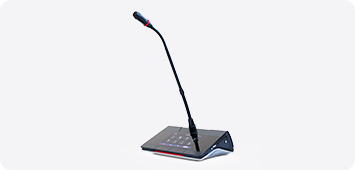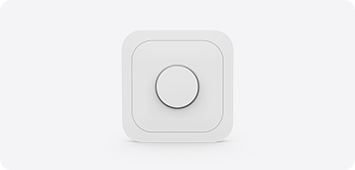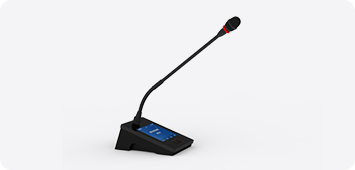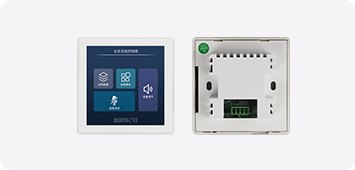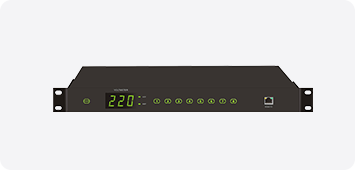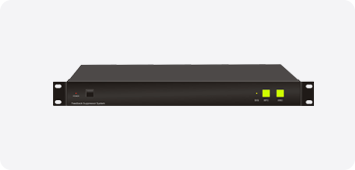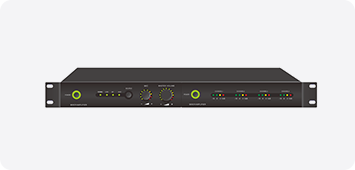

















Overview:
The gradient beam DSP column speaker is based on in-depth research on space acoustics and exploration of sound wave radiation in the vertical and horizontal directions. By adding physical directional waveguides, the generation of useless side lobes is suppressed and the expected directivity is obtained.
In the horizontal direction, through a combination of physical structure design and DSP signal processing, three directional beams with different horizontal radiation angles are formed, respectively responsible for sound field coverage in the near field, midfield and far field. The sound pressure coverage intensity of each beam can be adjusted, and the near field can be adjusted through DSP to achieve horizontal directivity adjustment, achieving the effect of hitting wherever you point in the horizontal direction.
Asymmetrical vertical radiation technology is processed through digital DSP technology, which implements a gradual delay for 3 beams of sound waves, and combines a specially designed acoustic structure to process each beam of sound waves to produce an asymmetrical vertical radiation pattern, forming a downward Radiation angle, obtain the final required time domain and amplitude, and provide consistent radiation sound pressure level, while having a strong suppression effect, thereby improving the uniformity of spatial sound wave radiation, eliminating listening blind spots, and improving speech amplification It can improve the sound clarity, especially when used in spaces with long reverberation times. It has the effect of anti-reverberation and can increase the speech clarity in reverberant environments.
This type of column speaker is widely used in large and medium-sized command centers, lecture halls, religious sites, airports, train stations, lobbies, convention and exhibition centers, museums, etc.
Features:
1. Use directional waveguide technology to suppress the generation of useless side lobes and obtain the expected directivity.
2. Horizontal radiation angle gradient beam technology forms 3 directional beams with different horizontal radiation angles, which are respectively responsible for sound field coverage in the near field, midfield, and far field. Each beam can adjust the sound pressure coverage intensity. According to the acoustic characteristics, the beam the narrower the beam, the farther the projection distance, and the wider the beam, the wider the radiation surface, but the radiation distance is not far, so the three beam settings are: 160 degrees for the near field beam, 100 degrees for the midfield beam, and 60 degrees for the far field.
3. Near-field beam directivity variable technology can realize horizontal radiation angle adjustment through DSP, which can radiate targeted areas, while ineffective areas can reduce radiation, such as reducing wall reflections and improving the interference and reverberation time of useless sound waves in space. Long, direct sound is obtained directly, improving speech clarity.
4. Asymmetric vertical radiation technology. In order to ensure that the front and rear sound fields are relatively uniform, traditional sound columns use physical methods to slant the speakers downward during installation. However, this affects the aesthetics of the speakers integrating into the space. To solve this problem, Using asymmetric vertical radiation technology processing, a gradual delay is implemented on the 3 beams of sound waves through digital DSP technology, and combined with a specially designed acoustic structure to process each beam of sound waves to produce an asymmetric vertical radiation pattern, forming a downward Radiation angle, and greatly reduce the upward emission of sound, attenuate the acoustic reflection of the ceiling, obtain the final required time domain and amplitude, and provide consistent radiation sound pressure level, while having a strong side-breaking effect. Strong direct sound, clean and clear sound.
5. AOIP network audio input technology supports mainstream network protocols.
6. Analog signal and digital signal input are optional, and mixed input is also possible.
7. Network management settings, the device can be managed and set in the network by directly connecting to the switch.
8. Powerful algorithm, intuitive interface, dedicated DSP management software, easy to set up, can perform beam control, 7-band equalization adjustment, high and low pass slope filtering, input level control, mute, preset settings, save and recall, system settings and other functions.
9. Built-in multi-channel high-stability digital power amplifier.
10. Dedicated full-range 3.5-inch high-quality speakers are used in the far field and midfield, and 2-inch full-range speakers are used in the near field. The sound wave coupling is scientific and the sound quality is clear and transparent.
11. The wooden box has a slender shape and a pleasing structure. It is available in black and white and is highly integrated with the space environment.
Acoustic specifications
Frequency response | 80 Hz - 20 kHz |
Maximum sound level | 122dB |
Horizontal coverage angle (gradient) | 160°、100°、60° |
Vertical coverage angle (asymmetrical) | 0°— -45° |
Typical range distance | 24 meters |
Maximum range distance | 36 meters |
Dynamic Range | 122 dB |
Speaker unit | 8 x 3.5" full range speakers, 8 x 2" full range speakers |
Sensitivity | 1W/1 m 96 dB |
Electronic parameters
Audio input | 1 line |
Normal input level | 0 dBu (2.19 Vpp) |
Maximum input level | 10 dBu (6.92 Vpp) |
Type | Balance/AOIP |
Impedance | 47 kOhms at 1 kHz |
Power amplifier
Type | PWM (Class D) |
Total power output | 500 W |
Power efficiency | 92% |
THD+N | 0.1% at 10 Wrms/channel |
Input signals | balance |
Channel protection | Overheating protection (>120°C), output short circuit |
DSP Module
DSP processor | 56-bit DSP 145 Mhz |
Sampling Rate | 48 kHz |
Signal processing | High-low pass |
Input EQ | (7-band) |
Volume | (-100 dBFSbis 0 dBFS) |
Delay | (1 ms) |
Input signal | detection |
Control Module
CPU | 32-bit, 24MHz |
Network Interface | UDP |
Processor activities | DSP start |
Remote input channel control | Network control |
PSU-Module
Communication scope | 90 VACS to 264 VACS (universal input) |
Input frequency | 47 Hz to 67 Hz |
Efficiency | 92.5% at 230 VACS |
AOIP Module
Network cable | 10BASE-T:Category 3, 4, 5 unshielded twisted pair (≤100 meters); 100BASE-TX:Category 5 and above unshielded twisted pair (≤100 meters) |
AOIP | 2 channels, plug and play, automatically discover devices |
Rate | 100M/1000M bps |
Sampling rate | 48K |
Data format | 24 bits |
Minimum delay | 1MS |
General parameters
Dimension | W*H*D125*1198*178 mm |
Weight | 14 kg |
Box material | Plywood |
Color | Black, White |
Temperature range | 0°C to 40°C (32°F to 102°F) |




